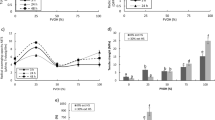Abstracts
This study aimed to explore ideal processing condition for black garlic based on the change of nutritional and active components and antioxidant capacity. Fresh garlic was processed under the condition of constant temperature (65, 75 and 85 °C) and relative humidity (70, 75, 80 and 85%) for 16 days. The sensory scores, contents of nutritional and active components, and antioxidant capacity were monitored. The sensory scores reached the maximum on the 8th day at 85% humidity and 75 °C. The contents of nutritional components were significantly affected by humidity and temperature, and 85% humidity and 75 °C were appropriate. The polyphenol content increased with increase in temperature and decrease in humidity. The reducing sugars and total sugars, total acids and 5-HMF were higher at 75 °C than at 65 and 85 °C. Reducing sugar and protein contents and sensory scores decreased on the 8th day. Maintaining the temperature of 75 °C and relative humidity of 85% for 8 days were ideal for black garlic to retain antioxidant capacity and abundant nutrients.




Similar content being viewed by others
References
Ak T, Gülçin İ (2008) Antioxidant and radical scavenging properties of curcumin. Chem Biol Interact 174:27–37
Arts MJ, Dallinga JS, Voss H-P, Haenen GR, Bast A (2004) A new approach to assess the total antioxidant capacity using the TEAC assay. Food Chem 88:567–570
Bae SE, Cho SY, Won YD, Lee SH, Park HJ (2014) Changes in S-allyl cysteine contents and physicochemical properties of black garlic during heat treatment. LWT Food Sci Technol 55:397–402
Bozkurt H, Göğüş F, Eren S (1999) Nonenzymic browning reactions in boiled grape juice and its models during storage. Food Chem 64:89–93
Chung LY (2006) The antioxidant properties of garlic compounds: allyl cysteine, alliin, allicin, and allyl disulfide. J Med Food 9:205–213
Delgado-Andrade C, Seiquer I, Haro A, Castellano R, Navarro MP (2010) Development of the Maillard reaction in foods cooked by different techniques. Intake of Maillard-derived compounds. Food Chem 122:145–153
Garzón G, Wrolstad R (2009) Major anthocyanins and antioxidant activity of Nasturtium flowers (Tropaeolum majus). Food Chem 114:44–49
Han J, Lawson L, Han G, Han P (1995) Spectrophotometric method for quantitative determination of allicin and total garlic thiosulfinates. Anal Biochem 225:157–160
Kwon O-C, Woo K-S, Kim T-M, Kim D-J, Hong J-T, Jeong H-S (2006) Physicochemical characteristics of garlic (Allium sativum L.) on the high temperature and pressure treatment. Korean J Food Sci Technol 38:331–336
Lan X, Liu P, Xia S, Jia C, Mukunzi D, Zhang X, Xia W, Tian H, Xiao Z (2010) Temperature effect on the non-volatile compounds of Maillard reaction products derived from xylose–soybean peptide system: further insights into thermal degradation and cross-linking. Food Chem 120:967–972
Ledl F, Schleicher E (1990) New aspects of the Maillard reaction in foods and in the human body. Angew Chem Int Ed Engl 29:565–594
Liang T, Wei F, Lu Y, Kodani Y, Nakada M, Miyakawa T, Tanokura M (2015) Comprehensive NMR analysis of compositional changes of black garlic during thermal processing. J Agric Food Chem 63:683–691
Liu H, Zhang J (2008) Antioxidant activity of carboxymethylated and sulfated polysaccharides from pumpkin [J]. Sheng Wu Jia Gong Guo Cheng 4:009
Okada Y, Tanaka K, Fujita I, Sato E, Okajima H (2005) Antiodidant activity of thiosulfinates derived from garlic. Redox Rep 10:96–102
Purev U, Chung MJ, Oh D-H (2012) Individual differences on immunostimulatory activity of raw and black garlic extract in human primary immune cells. Immunopharmacol Immunotoxicol 34:651–660
Qingming Y, Xianhui P, Weibao K, Hong Y, Yidan S, Li Z, Yanan Z, Yuling Y, Lan D, Guoan L (2010) Antioxidant activities of malt extract from barley (Hordeum vulgare L.) toward various oxidative stress in vitro and in vivo. Food Chem 118:84–89
Queiroz YS, Ishimoto EY, Bastos DH, Sampaio GR, Torres EA (2009) Garlic (Allium sativum L.) and ready-to-eat garlic products: in vitro antioxidant activity. Food Chem 115:371–374
Salman H, Bergman M, Bessler H, Punsky I, Djaldetti M (1999) Effect of a garlic derivative (alliin) on peripheral blood cell immune responses. Int J Immunopharmacol 21:589–597
Sasaki JI, Lu C, Machiya E, Tanahashi M, Hamada K (2007) Processed black garlic (Allium sativum) extracts enhance anti-tumor potency against mouse tumors. Energy (kcal/100 g) 227:138
van den Berg R, Haenen GR, van den Berg H, Bast A (1999) Applicability of an improved Trolox equivalent antioxidant capacity (TEAC) assay for evaluation of antioxidant capacity measurements of mixtures. Food Chem 66:511–517
Wang D, Feng Y, Liu J, Yan J, Wang M, Sasaki J-i LuC (2010) Black garlic (Allium sativum) extracts enhance the immune system. Med Aromat Plant Sci Biotechnol 4:37–40
Wang X, Jiao F, Wang Q-W, Wang J, Yang K, Hu R-R, Liu H-C, Wang H-Y, Wang Y-S (2012) Aged black garlic extract induces inhibition of gastric cancer cell growth in vitro and in vivo. Mol Med Rep 5:66–72
Wootton-Beard PC, Moran A, Ryan L (2011) Stability of the total antioxidant capacity and total polyphenol content of 23 commercially available vegetable juices before and after in vitro digestion measured by FRAP, DPPH, ABTS and Folin-Ciocalteu methods. Food Res Int 44:217–224
Xiao H, Parkin KL (2002) Antioxidant functions of selected allium thiosulfinates and S-alk (en) yl-l-cysteine sulfoxides. J Agric Food Chem 50:2488–2493
Zhang Z, Lei M, Liu R, Gao Y, Xu M, Zhang M (2015) Evaluation of alliin, saccharide contents and antioxidant activities of black garlic during thermal processing. J Food Biochem 39:39–47
Acknowlegements
This work was supported by National Natural Science Foundation of China (31301535), Qing Lan Project and Xuzhou science and technology plan (KC14NO069).
Author information
Authors and Affiliations
Corresponding author
Rights and permissions
About this article
Cite this article
Sun, YE., Wang, W. Changes in nutritional and bio-functional compounds and antioxidant capacity during black garlic processing. J Food Sci Technol 55, 479–488 (2018). https://doi.org/10.1007/s13197-017-2956-2
Revised:
Accepted:
Published:
Issue Date:
DOI: https://doi.org/10.1007/s13197-017-2956-2




